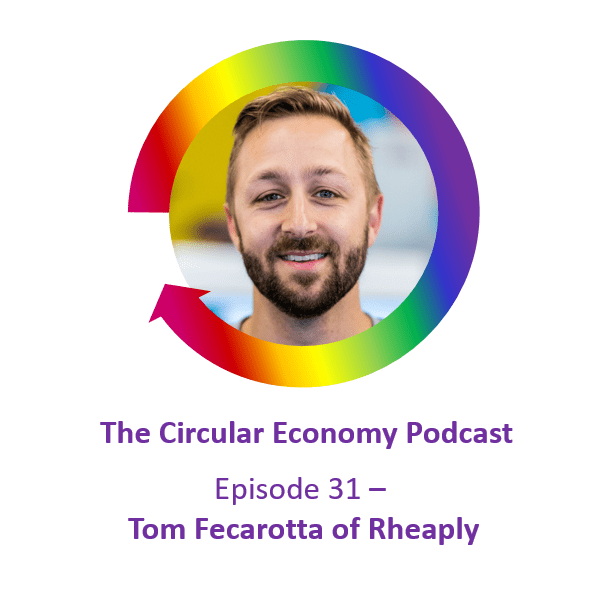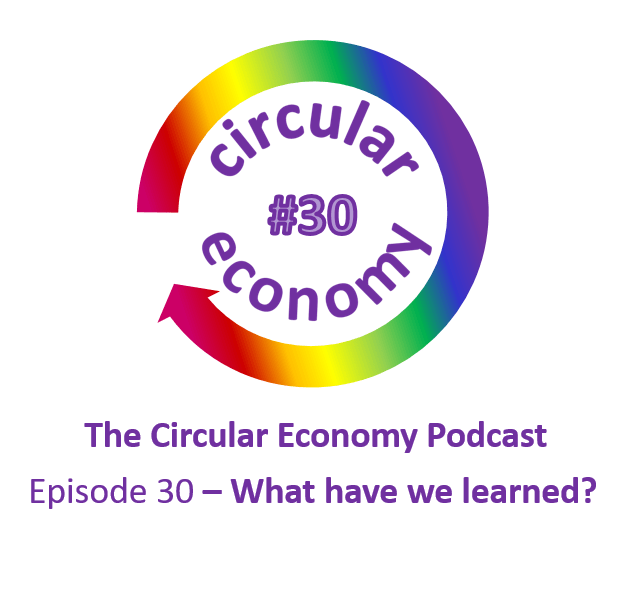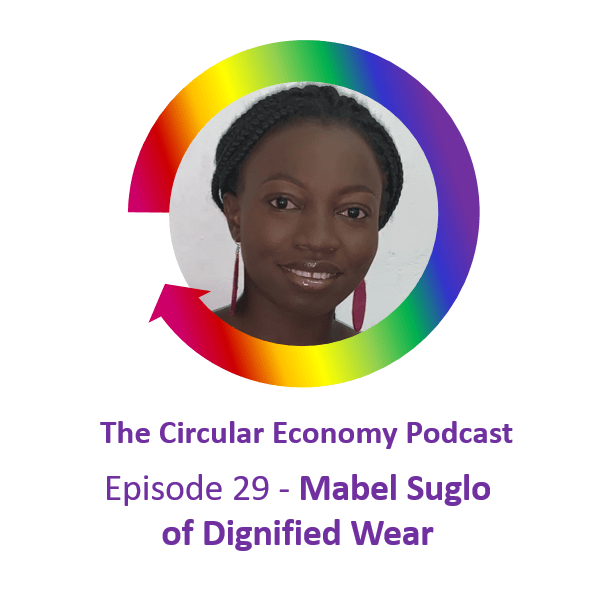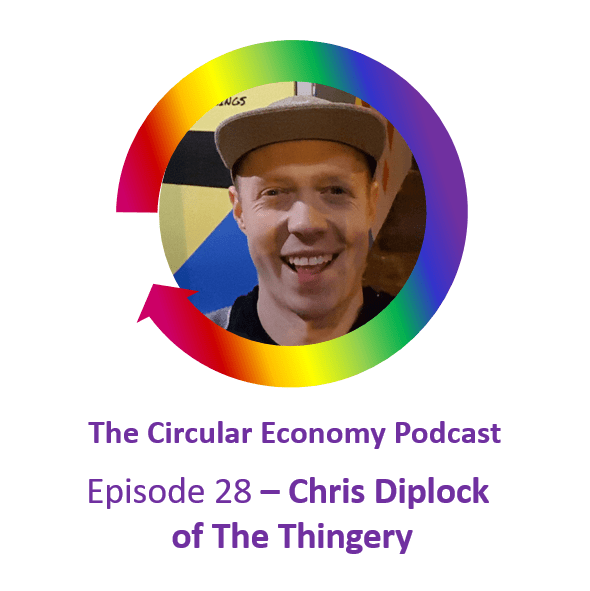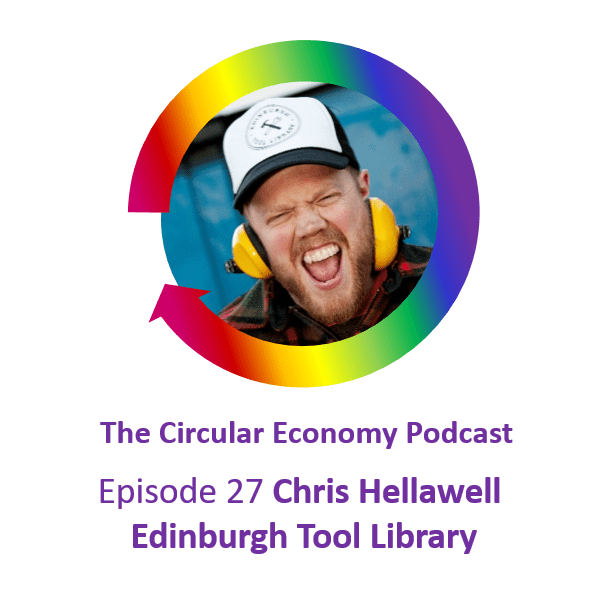Podcast: Play in new window | Download
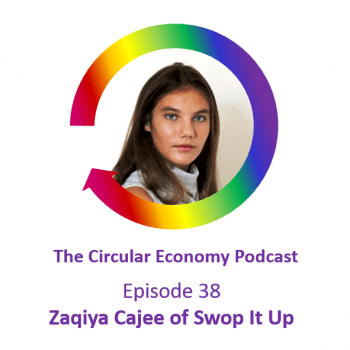 Weetman talks to Zaqiya Cajee, a young entrepreneur in the UK who has set up a not-for-profit scheme. SwopItUp helps young people to swap their fashionable clothes, so they can experiment with different trends, colours, shapes and so on, without being part of the throwaway culture – and save money!
Weetman talks to Zaqiya Cajee, a young entrepreneur in the UK who has set up a not-for-profit scheme. SwopItUp helps young people to swap their fashionable clothes, so they can experiment with different trends, colours, shapes and so on, without being part of the throwaway culture – and save money!
We’ll hear how SwopItUp is developing technology to engage users and to help overcome the challenges of distancing during lockdow, to reduce the risk of the virus spreading via the clothes, and to track and analyse swapping trends.
Podcast host Catherine Weetman is a circular economy business advisor, workshop facilitator, speaker and writer. Her award-winning book, includes lots of practical examples and tips on getting started. Catherine founded Rethink Global in 2013, to help businesses use circular, sustainable approaches to build a better business (and a better world).
Stay in touch for free insights and updates…
Read on for a summary of the podcast and links to the people, organisations and other resources we mention.
You can subscribe to the podcast series on iTunes, Google Podcasts, PlayerFM, Spotify, TuneIn, or search for “circular economy” in your favourite podcast app. Stay in touch to get free insights and updates, direct to your inbox…
Links we mention in the episode:
- Big Reuse Week podcasts https://www.mywaste.ie/reuse-month-event/the-big-reuse-event-part-1/
- SwopItUp https://www.swopitup.org/ and @SwopItUp on Facebook, Twitter and LinkedIn
- Zaqiya on Instagram & Twitter @zaqiyacajee
- Read more about Zaqiya here https://juliesbicycle.com/news/swopitup-young-people-fast-fashion/
- Reusing school uniforms – Episode 11 – Izzie Eriksen of ApparelXchange https://www.rethinkglobal.info/apparelxchange-reuse-school-uniforms/
- Renting and subscriptions for baby clothes – Episode 18 – Eve Kekeh of Bundlee https://www.rethinkglobal.info/episode-18-eve-kekeh-of-bundlee/
- Richard MacCowan at Biomimicry UK https://www.bio-uk.org/
- Amy and Ella Meek from Kids Against Plastic https://www.kidsagainstplastic.co.uk
About Zaqiya Cajee
 Leading the charge in tackling the issue of fast fashion is 17 year-old Zaqiya Cajee.
Leading the charge in tackling the issue of fast fashion is 17 year-old Zaqiya Cajee.
Founder of the SwopItUp scheme, Zaqiya is encouraging teenagers across the country to swop their clothes and dispel the throwaway nature of today’s fashion.
The scheme sees students hand-in unwanted items of clothing, in exchange for tokens, which then form the ‘Swop Store’.
Zaqiya’s ultimate goal is to have 25 schools running SwopItUp by 2021, soon after broadening it to become a national, eventually even international, enterprise.
Transcript
Add ~2:40 to these timings for the finished episode
Catherine Weetman 00:06
Today we’re talking to our youngest guest so far, 17 year old Zaqiya Cajee. Zaqiya is tackling the issue of fast fashion by encouraging teenagers across the country to swap their clothes and rethink the throwaway culture of today’s fashion. Zaqiya is the founder of SwopItUp, a not-for-profit Community Interest Company in the UK. The scheme sees students hand in unwanted items of clothing in exchange for tokens, which then form the Swop Store. Zaqiya’s ultimate goal is to have 25 schools around the country running SwopItUp by 2021, then to broaden it to become a national and eventually international enterprise. Zaqiya, welcome to the Circular Economy Podcast.
Zaqiya Cajee 00:51
Hi, Catherine, thank you so much for having me.
Catherine Weetman 00:54
It’s great to talk to you. And I was talking to a friend of mine Richard MacCowan of Biomimicry UK a bit earlier on today. And when I said I was interviewing you this evening, he was full of compliments about about you, and about SwopItUp. So your your reputation is spreading already. So before we get to how Swop It Up works, I’m curious to know about your ‘why’. What sparked your interest in this? How did did it start with fashion? Or did it start with reducing waste or what?
Zaqiya Cajee 01:29
It started mainly with fashion Actually, I originally had quite a big interest in fashion and style. And it’s always really interested me. But then, when I was around 14-15, I then became more and more in love with this subject of geography and specifically around the environment and climate change. And then, when the report was released, saying that we had 12 years left to combat climate change before it’s irreversible, I realised that, Okay, I need to do something. At the same time, I was on holiday in Italy, and I had been going to these markets where they were selling pre loved clothes for only a couple of euros each. And I came back from that sort of experience thinking, Okay, what, there’s something in this, what can I do around pre love clothes at home. And then I started just to do more research into fast fashion and into how there isn’t actually that much of a market for my age group for pre loved clothes, because there’s a lot of charity shops for older people. But there’s also charity shops for much younger children as well. But there isn’t really anything from my age group. And so I thought I need to fit in that void. And that’s kind of where I was born from.
Catherine Weetman 02:52
Brilliant. So you spotted a gap in the market. And I think you’re right, the charity shops can supply kind of pre loved and vintage clothes for those two age groups. But also the issue with charity shops is you know, it’s quite a small selection, you’ll you’ll just be able to see what other people have donated in your, in your area. And because you know, that might be quite a large town, it can it’s not necessarily fashion items as it is people things that people might have had in their wardrobe for 10 or 15 years and finally decided that they haven’t worn this for the last five years. So it’s time to, to clear it out. So from what I can see on the website, SwopItUp is much more about helping people experiment with fashion. So tell us a bit about how it how it works. How do people use SwopItUp?
Zaqiya Cajee 03:48
So before COVID-19, the process of a Swop Shop was that you would bring in your clothes to school during the swap to drop week, which is when you would bring in your clothes and you would get tokens in exchange for them. And you would get more tokens for example for a coat than you would for a T shirt. And and so then the following week, you’ll be able to then spend those tokens on other clouds in the swap store. So a classroom would be laid out like a shop and clothes would be laid out and you’ll be able to go around pick up the ones that you like, you can go try them on in sort of like little changing facilities, they’re usually set up. And then you can swap your tokens for the clothes, so there’s no transaction of cash. It’s only these tokens and we made sure that all the processes such as so the tokens are made up of biodegradable paper, and stickers, also biodegradable. And so we made sure that every single process was and every single line item was in as environmentally friendly as possible.
Catherine Weetman 04:54
Hmm. And you kind of set a few rules like saying something else. To be cleaned before people donate it, and all that kind of thing, so that it becomes, you know, everybody, everybody knows that the clothes are going to be pristine and ready to wear and so on.
Zaqiya Cajee 05:10
Yes, so we do tell everyone that they should bring in the clothes washed. However, we do also advise people that when they take them home, they should wash them before they wear them, because we can’t guarantee that they have been washed. And washing it twice. It isn’t going to be too bad. Just make sure you do it on a full load. Because again, that is the best thing for the environment.
Catherine Weetman 05:34
Yeah, exactly. Well, well said, Yeah, there’s, there’s quite a lot of focus now on how to care for your clothes without using lots of water and detergents and so on. And how does so swap it up? your organisation is helping schools around the country do this. So if a school wants to sign up, what happens then what how do you support the school.
Zaqiya Cajee 05:59
So if the school signs up at the moment, we’ve kind of going into a new process of trying to be a bit more digital and a bit more online rather than being physical and swapped between because of the fact that we need to be thinking about social distancing. And there is also the trouble of having classes mixed and having year groups mixing in schools, because a lot of them have been bubbled, so they’re separate. And so to overcome that, we’re thinking of developing an app, which is going to allow for students to upload their clothes and also see the clothes that are being sold in the school. And then to go in and collect them. So school be used more as a drop off, and then click and collect sort of point rather than being the swap store that everything would be exchanged in. And so one of the things that we’re thinking now, if schools want to sign up is that we’re currently going to be doing a test phase of this app with two schools. And then hopefully, by the spring term, we will have a final app that we can then tell schools about and that they can sign up to and create their accounts for them and for their students. And it’ll be very easy to sign up to it, and can be quite flexible in terms of the school’s needs as well. And so they need to go over to our website to just sign up and say that they’re interested in being one of the schools that takes on the project, and then one of our team will be in touch with them, and will guide them to the process and sign them up. Hmm,
Catherine Weetman 07:46
yeah, that sounds good. So just like lots of other fashion businesses, over the, the pandemic and lockdown, you’ve had to suddenly switch to being to be able to operate online. And I guess having an app gives you other possibilities, like, you know, giving people reward points for being the person who swapped the most, or gain the most points over a season or maybe even helping classes and schools, you know, compete with each other and having a league table for the school with the most most swaps or all season.
Zaqiya Cajee 08:22
Yes, exactly, it’s going to help us collect a lot more data in terms of how many clothes are being swapped, and sort of also the footprint of that that is being saved. And so I reckon we will try and create competitions between schools in between classes, to then also have prizes at the end. So also allow us to track how much carbon is sort of being saved from the atmosphere, we can run averages on what a T shirt will be able to collect, and be able to save from the atmosphere, as well as other measurements such as water usage as well. And the more information that’s therefore put on the app, when someone uploads an item of clothing, the more that we can then be as accurate as possible, when creating and submitting that data.
Catherine Weetman 09:13
That’s good. And I think people get really motivated by seeing how much they’ve been able to do for the environment through their own actions. So being able to see over the course of the year that all the swaps you’ve done and all the clothes that you’ve donated have saved this many litres of water and this much energy. So Zaqiya, over the over the short time so far that you’ve been building this business, what kind of things have you struggled with and what surprised you in the process of setting up Swop It Up?
Zaqiya Cajee 09:45
One of the things that we’ve encountered is sort of behaviour, behavioural change and people’s lack of willingness to change their behaviours around consumption. And I’ve had a lot of people coming up to me and saying, Oh, this sounds amazing, this is so great. We’ve done assemblies, and they’ve just said, they really want to get involved. But then I don’t always see those same people turn up to the event. And, and that is something I’d like people to keep in mind is that if you’re going to congratulate someone on doing something and saying that doing a really good job, sometimes you also need to go and show your active support and not just tell them, you support them. And, and I’m sure quite a few other and certainly circular economy, businesses feel the same thing where people are going, Oh, that’s such a cool idea. But don’t follow through on their actions with that, as well. And I think that’s something that we need to start to see changing is behavioural change, because people do a lot of talking about what they want to see and what they think is really good. But don’t act upon those words that they say.
Catherine Weetman 11:04
Yeah, and I think maybe the, the app, and being able to showcase some of the people who were really engaging can be a way of encouraging those who are perhaps, you know, maybe they’re nervous, because people might think, well, I’ll bring this thing that I think is a really cool, you know, top or something like that. And what if it sits there and on sale for the rest of the year? Does that make me look like I’m not trending, because, you know, something I thought was cool, nobody else wants. And sometimes it’s just habits isn’t that people forget, and, and you know, that they meant to bring it today, and then they forgot, and then they’re embarrassed. But I think this kind of, you know, being able to almost gamify it and and give shoutouts to the people who would who are doing it and and use that in your social media can make it into a really cool thing. I remember early on in the podcast series, we were talking to is Eric’s Novak apparel exchange up in Scotland. And so what they’re doing is swapping school uniforms. And one of the things that she was found finding was that people were very happy to donate school uniforms in very good condition. But there was kind of a bit of a stigma around being the one to use the pre use school uniforms. So think, you know, that’s starting to change as rental and subscription services and reuse platforms like Vesti air, and the real real and so on, they’re getting really cool. So it’s just a bit of a mindset changes. net. And I think it’s one of these things that once you get past the tipping point, then people really, really get into it.
Zaqiya Cajee 12:49
Yes, I think there is quite a bit of stigma around second hand, which is why I like to use the phrase pre loved more because it has more positive connotation to it. And, and therefore going forward, I think we should start to use that more pre-loved rather than second hand, because second hand kind of reminds you of it being more of a hand me down from the older sibling, which you don’t have flexibility with style at that point, because you’re being subjected to your older sibling style, your old cousin style. Whereas when you then go and find pre loved clothes, in a swap or at a charity shop, you get to still decide if you want it or not. And if it matches your personal style, you’re not restricted in that sense. And also, when you find something that you really like, and it fits you, and you just feel great in it, you kind of know you are meant to have it because it’s a unique piece that is there that there aren’t 10 or 20 or 30 of them also, they’re in different sizes. And that’s something really magical about just swapping and going to charity shops for me is that you just know that what you’ve got you were meant to have, and it just feels like destiny.
Catherine Weetman 14:06
Hmm. And in doing that, you’ve also saved a load of water and energy and waste. So you kind of got that story behind it as well and you and it and it’s cost you an awful lot less than going to the stores to to buy it.
Zaqiya Cajee 14:22
Exactly.
Catherine Weetman 14:23
So it looks as if you’re building quite a big support team at swap it up. So there’s a social media team community engagement, and a volunteer advisory board. What kind of things are they doing to help you spread the word and get more schools involved?
Catherine Weetman 14:37
So the social media team are really really good at just posting we’re getting posts out pretty much every day. And that is just growing sort of the support that we’re getting from followers on we’re mainly using Instagram as Ashley as our target audience will be mainly using that platform But we are also on Twitter and Facebook. And LinkedIn is really good. From a professional perspective. Twitter’s really good from the school’s perspective, because a lot of teachers and a lot of schools have Twitter accounts. And so it’s quite nice to interact with them on that sort of basis. And then from a sort of community outreach side of things, there’s also people that are kind of working in fundraising. And so that’s great and, and just making sure we’ve got enough support behind us. And making sure that we do have enough money to support us to then go out and reach out to schools and to then support the schools that we have, and signed up to us to suck it up. And, and then we’ve got the volunteers, we’ve got the team volunteers, who are doing a bit of everything they’re doing social media, if they want to be doing social media, they’re creating, and some really fantastic art pieces and some great embroidery as well. And some shoes that one of the volunteers is done as an example of a way that you can upcycle and old shoes into something new and a bit more personal. And then we’ve also got a team of those students who will be working on developing this app. And then to take it out to schools. And so they will be doing quite a bit of the school contact and be making sure that we’re emailing them and making sure that everything’s running as smoothly as possible. And they’re having the adults of supporting them in a in a mentoring capacity. And, but we’re trying to encourage as many teenagers and young people to get involved as possible, because it really, I really, really want it to be a programme that is led by young people, and it’s for young people.
Catherine Weetman 17:18
So you kind of needed a champion, you know, somebody in the school classes as a champion, rather than it being a cheap a teacher wanting to bring this in.
Zaqiya Cajee 17:30
Exactly yeah, we’ve got teachers who are there to support again, to make sure that you have access to the right rooms, and you have access to assemblies and all these sorts of things. And sort of just get you as your headway into things. But a lot of the time, there is a project lead at each school, which is a student member who will be sort of organising, telling people what they need to do. And, and we’ll try and do as much of the organising of the rooms and the assembly times and everything as possible, but they will, and consult the support teacher to make sure that if they have any troubles, then they can overcome those.
Catherine Weetman 18:18
Yeah, sounds good. Sounds like you’ve thought a lot about the the whole back office and organisation side of things. So I’m guessing the lockdown and, and most schoolchildren being homeschooled has been problematic. And you talk to you a bit about what you what you’re able to do virtually Are there any other things that you need to do differently around, you know, preventing virus contamination, so on the clothes.
Zaqiya Cajee 18:47
And so one of the things that we’re putting into place is that you would only bring in the clothes when someone has on the app said that they want to buy the clothes or swap for the clothes. And and so then you will be notified that someone wants your clothes, and you would bring it in, then you would wait a three day period before you can then go in and collect the clothes. And that’s sort of a standard sanitary period in which it the clothes can set and the virus should no longer be there if there is any remnants of it, and when you pick it up. But again, we do say wash it before you bring it in and wash it when you take it home just to avoid anything, and we don’t want to be liable for anything.
Catherine Weetman 19:39
No, no, that sounds good. And yeah, I think there’s quite a lot of science to say that on fabrics and paper and things like that the virus only has a life of about 12 hours or so. Whereas on metal surfaces it you know it can it can be a bit longer and so brilliant. So In terms of thinking about the circular economy and your interest in that, who would you recommend as a future guest for the programme to inspire people about the circular economy?
Zaqiya Cajee 20:10
I’m going to nominate two sisters called Amy and Ella from they are the founders of Kids against Plastic. And they are doing such a great work with just the campaign to do with reducing the amount of plastic and raising awareness and challenging companies on why they’re using plastic on their product. And that certain labels as to why it says recycled on it. What exactly does this mean? And, and to sort of bring in to view a lot more into the public eye? That companies can’t just keep throwing around words such as sustainability and recycled without explaining fully what that means.
Catherine Weetman 20:59
Yeah, that’s, that’s really good. And that reminds me of a quote, I’d made a note of for a keynote I was doing on on fashion sustainability earlier today that I then forgot to use, which was the founder of I think it’s Boyfriend Jeans, who was saying sustainability is like the Wild West. In other words, there’s just no rules. You know, anybody can say anything, and kind of claim that it’s, it’s sustainable.
Zaqiya Cajee 21:30
There’s a lot of greenwashing going around
Catherine Weetman 21:32
Yeah, I agree. Far too much greenwashing. And yeah, let’s let’s hope those companies get called out and live to regret the fact that they’ve tried to dress something up as as as being green, I think, eco bamboos my current, favourite, you know, growing bamboo is Eco, but the process of turning it into a fabric definitely is not eco. So yeah. And what are your lessons learned, and top tips for anybody wanting to go more circular in their lives or in the business?
Zaqiya Cajee 22:08
So I would say in terms of a business is to just think about everything. So think about the process of your business from the beginning of the production cycle, to when it leaves you and then beyond that, and just think, where where could we then lose control of it, because a lot of the time within the circular economy, the idea is that it stays quite circular. But what can happen is you can have drips of sort of linear economy coming out of it, because people won’t always send it back, if that’s how you want your circular economy business to work. And people will throw things away. And so you need to then think of Okay, so if someone does throw this away, how is this? Okay, okay, we’re gonna make sure that it’s made up of bio plastic instead of fossil fuel, chemical, plastic, and, and that’s just going to, again, it’s not the best scenario, but it’s just thinking about all these things that could happen. So I would just recommend that you just have a good think about all the processes in the production cycle, but also to think about, say, in your office space, are you on a green tariff? And are you using LED bulbs? What other changes can you make not just to do with the product you’re making, but also within the business itself?
Catherine Weetman 23:31
Yeah, that’s a really good point. And I think, even if a business is selling services, or it’s a retail business, and it can’t really do anything about, you know, the, the, the products, it’s reliant on the manufacturer to do something, there are all sorts of other things that you can do with procurement, like, you know, trying to buy services yourself instead of taking ownership of things. And if you’re buying things like office furniture, and so on, can you buy a remanufactured? Or can you insist that somebody has a take back clause in the contract so that when you’ve finished using something, they have to take it back? And that focuses people’s mind differently, doesn’t it if you’re, if you’re responsible for the product, after it’s left your door, then you make all sorts of different decisions on the materials, the design and so on brilliant,
Zaqiya Cajee 24:19
and also to just be as a business as transparent as possible, because that will often also show perhaps holes in your business plan. Because you will realise, oh, okay, we aren’t explaining that bit because of something, okay, we need to change that. And that just allows you to have that transparency with your customer. But it also allows you to find holes in your business. And that’s not a bad thing. It just means it’s something to improve upon.
Catherine Weetman 24:48
Yeah, definitely. And Patagonia, take that approach. So if they find something that, you know, they that they don’t like, and they’re embarrassed about, they don’t keep quiet about it, they put it into the public arena and then say what they’re planning to do about it. But yeah, you know, a couple of times, they’ve been shocked to find that some offshore supplier had said they were doing one thing and was actually doing another. And so rather than trying to sweep it under the carpet, and hope nobody finds out, they’ve gone public with it, which is, you know, it builds trust in the brand, doesn’t it? If they can be honest about the bad news, and not just about the good stuff they’re doing? So Zaqiya, if people want to find out more about you and swap it up? How can they get in touch.
Zaqiya Cajee 25:39
So in terms of getting in touch with me, I am available on Instagram, Twitter, and LinkedIn. And, and they’re all @Zaqiya Cajee, and it’s about Zed a QIYAC. A JE. And then to find out more about SwopItUp and follow us on our platforms, which is on Instagram, Twitter, Facebook, and LinkedIn that’s, SwopItUp. spelt, SW, p it up.
Catherine Weetman 26:11
Brilliant. That’s great. And we’ll put those links in the show notes at www circular economy podcast.com. For anybody who wants to find out more secure, thank you for taking us through all that. And I wish you the best of luck with the beta phase of the app. And I hope you get the word out there and get more people stepping over that, that threshold between thinking this is a good idea, and actually getting involved and then obviously getting excited about it and getting excited about the difference that they’re making, and the fact that they’re now part of the solution and not part of the problem. Thank you very much.
Zaqiya Cajee 26:49
Thank you and thank you so much for having me again.
Want to find out more about the circular economy?
If you’d like to learn more about the circular economy and how it could help your business, why not listen to Episode 1, or read our guide: What is the Circular Economy?
To go deeper, you could buy Catherine’s book, A Circular Economy Handbook for Business and Supply Chains This comprehensive guide uses a bottom-up, practical approach. It includes lots of real examples from around the world, to help you really ‘get’ the circular economy. Even better, you’ll be inspired with ideas to make your own business more competitive, resilient and sustainable.
Please let us know what you think of the podcast – and we’d love it if you could leave us a review on iTunes, or wherever you find your podcasts. Or send us a Tweet: @Rethink _Global.
Podcast music
Thanks to Belinda O’Hooley and Heidi Tidow, otherwise known as the brilliant, inventive and generous folk duo, O’Hooley & Tidow for allowing me to use the instrumentals from the live version of Summat’s Brewin’ as music for the podcast. You can find the whole track (inspired by the Copper Family song “Oh Good Ale”) on their album, also called Summat’s Brewin’. Or, follow them on Twitter.
